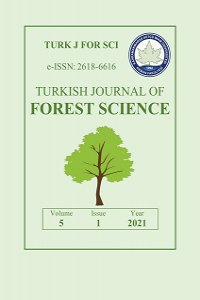TUTKAL TÜRÜ VE GÜÇLENDİRİCİ TÜRÜNÜN BÜKME LVL’NİN EĞİLME DEFORMASYONU ÜZERİNE ETKİSİ
Bu çalışmada güçlendirilmiş bükme LVL’lerin eğilmede deformasyon miktarı üzerine güçlendirici ve tutkal türünün etkisi incelenmiştir. Çalışma kapsamında ahşap malzeme olarak 2,2mm soyma kavak kaplama, 1,5mm soyma kızılağaç kaplama kullanılmıştır. Güçlendirici olarak cam elyafı ve bazalt kumaş (200g/m²) kullanılmıştır. Alt ve üst yüzeyde kızılağaç kaplaması, orta tabakalarda kavak kaplama kullanılmıştır. Güçlendirici malzeme bükme LVL’nin dışbükey yüzeyine uygulanmıştır. Toplam 7 farklı kombinasyonda sandalye ayak-kolçak formunda bükme LVL üretimleri yapılmıştır. Üretilen LVL’lere eğilme testi, çekme testi ve ANSYS programında eğilme testi yapılmıştır. Test sonuçlarına göre güçlendirici kullanımı ile eğilme deformasyonunda azalma olduğu tespit edilmiştir. En iyi sonucun cam elyafı ve epoksi kullanımı ile sağlandığı belirlenmiştir. Ayrıca ANSYS sonuçları ile gerçek test sonuçlarının benzer olduğu görülmüştür.
Anahtar Kelimeler:
Bükme tabakalı kaplama kereste, ANSYS, epoksi, cam elyafı, mekanik özellikler
THE EFFECT OF ADHESIVE TYPE AND REINFORCEMENT TYPE ON FLEXURAL DEFORMATION OF BENDING LVL
In this study, the effect of reinforcement type and glue type on the amount of flexural deformation of reinforced bending LVLs was investigated. Within the scope of the study, 2.2mm peeled poplar veneer and 1.5mm peeled alder veneer were used as wood material. Glass fiber and basalt fabric (200g/m²) were used as reinforcement. Alder veneer was used on the lower and upper surfaces, and poplar veneer was used on the middle layers. Reinforcement material was applied to the convex surface of the bending LVL. A total of 7 different combinations of bending LVLs in the form of chair leg-armrest were produced. Flexural test, tensile test and ANSYS analysis were performed on the produced LVLs. According to the test results, it was determined that there was a decrease in flexural deformation with the use of reinforcement. It was determined that the best results were obtained with the use of glass fiber and epoxy. In addition, ANSYS results and real test results were found to be similar.
___
- As, N., Büyüksarı, Ü., (2010). Masif Ağaç Malzemenin Bükülmesi, Istanbul University Journal of the Faculty of Forestry, c. 60, sayı 1, s. 29–37.
- ASTM D899. (1994). Standard test method for applied weight per unit area of liquid adhesive, American Society for Testing Materials, Philadelphia.
- ASTM D3500-20. (2020). Standard Test Methods for Wood Structural Panels in Tension, American Society for Testing Materials
- Bal, B.C., Bektaş, İ., Mengeloğlu, F., Karakuş, K., Demir, H.Ö., (2015). Some Technological Porperties of Poplar Plywood Panels Reinforced with Glass Fiber Fabric, Construction and Building Materials, 101; 952-957.
- Dallı, G., (2005). Türkiye’de kaplama tabakalı kereste (LVL) üretim imkanlarının araştırılması ve teknolojik özellikleri. Yüksek Lisans Tezi. İstanbul Üniveritesi. Fen Bilimleri Enstitüsü. İstanbul. 103s.
- Hammond, J. and Donnelly, E. T., (1966). Woodworking Technology, 2. baskı. McKnight & McKnight Publishing Co.
- Hortaç, H. K., (1988). Bükme Mobilya Üretim Teknikleri Üzerine Araştırmalar, Yüksek Lisans Tezi, Hacettepe Üniversitesi Fen Bilimleri Enstitüsü, Ankara.
- Karayılmazlar, S., Çabuk, Y., Atmaca, A., Aşkın, A., (2007). Orman ürünleri endüstrisinde laminasyon tekniği ve önemi. Zonguldak Karaelmas Üniversitesi Bartın Orman Fakültesi Derigisi, s. 78–86.
- Moradpour, P., Pirayesh, H., Gerami, M., Jouybari, I.R., (2018). Laminated Strand Lumber (LSL) Reinforced by GFRP; Mechanical and Physical Properties, Construction and Building Materials, 158;236-242.
- Nelson, S., (1997). Structural Composite Lumber. Engineered Wood Products: A Guide for Specifiers, Designers and Users. Edited by Stephen Smulski. PFS Research Foundation, Madison, WI. s. 147-172.
- Wagner, W. H., Kicklighter, C. E., (2000). Modern Woodworking. Goodheart- Willcox Publisher.
- Wright, R. S., (2011). Vacuum Steam Technology for Rapid Plasticization and Bending of Maple, Virginia Tech.
- Yayın Aralığı: Yılda 2 Sayı
- Başlangıç: 2017
- Yayıncı: Kahramanmaraş Sütçü İmam Üniversitesi
Sayıdaki Diğer Makaleler
KABUK BÖCEĞİ DUYARLILIĞININ KALAN MEŞCERE ÜZERİNE ETKİLERİNİN ARAŞTIRILMASI
Gonca ÖZCAN, Korhan ENEZ, Fatih SİVRİKAYA
TUTKAL TÜRÜ VE GÜÇLENDİRİCİ TÜRÜNÜN BÜKME LVL’NİN EĞİLME DEFORMASYONU ÜZERİNE ETKİSİ
ORTAÖĞRETİM MOBİLYA VE İÇ MEKÂN TASARIMI EĞİTİM PROĞRAMI VE EĞİTMEN GÖRÜŞLERİ ÜZERİNE BİR ARAŞTIRMA
Mehmet Hüseyin AKÇAY, Bülent AKGÜN
KIRIKKALE ÜNİVERSİTESİ ÖĞRENCİLERİNİN PERMAKÜLTÜRE YÖNELİK TUTUMLARININ BELİRLENMESİ
Mahire ÖZÇALIK, Orhan KAVUNCU, Şükran ŞAHİN
REKREASYON HİZMETİNE AYRILACAK ALANLARIN BELİRLENMESİ VE İŞLETME SINIFININ OLUŞTURULMASI
